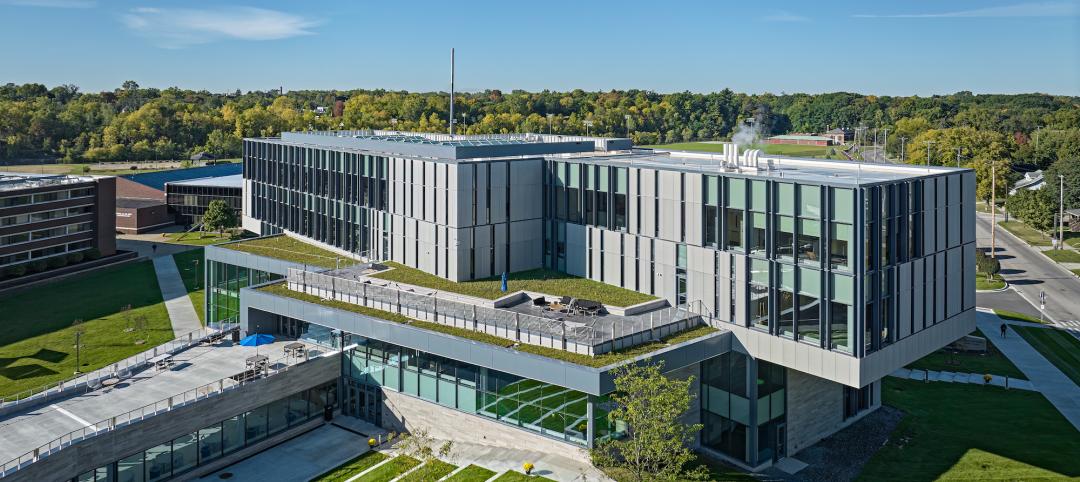Effective September 1, the University of Texas at San Antonio will launch its College of Engineering and Integrated Design (CEID), one of the few academic programs in the U.S. that combine engineering, architecture, and construction.
The new college will have 4,300 students, 117 faculty members, and 41 staff. It is the result of a year-long discussion by the University’s Integrated Design Initiative Task Force, that was formed in April 2020. Also instrumental in encouraging this consolidation is the San Antonio office of LPA Architects, whose Principal Mark Oppelt sits on the University’s Professional Advisory Council, and whose firm has long advocated the cross-pollination of engineering and architecture, especially now when the industry’s response to climate change requires more complicated solutions that involve both disciplines.
“This is the path the industry will need to travel for a more sustainable world,” Oppelt tells BD+C. He explains that as LPA has honed its specialty in sustainable design, it has come to appreciate the importance of incorporating engineering into the design process that often calls for complex MEP and HVAC systems to achieve sustainable results.
LPA Architects, with six offices in the U.S., is the largest architecture firm to meet or exceed AIA’s 2030 Challenge targets over the last two years. “We want our designers to understand engineering, and our engineers to understand design,” says Oppelt.
“LPA is a national leader in integrated design, and having Mark on the Advisory Council has been very impactful in informing the best way to shape this new program,” states Sedef Donager, Ph.D, Interim Director of the School of Architecture and Planning.
ONE COLLEGE, TWO SCHOOLS, THREE DEPARTMENTS
The new college brings together the academic departments and programs formerly under the College of Engineering and the College of Architecture, Planning, and Construction. CEID is organized administratively into two schools: one for Civil and Environmental Engineering and Construction Management; and another for Architecture and Planning. The new college has three departments: biomedical and chemical engineering, mechanical engineering, and electrical and computer engineering.
While students and faculty had collaborated on projects when the two colleges were separate entities, this combination will present more students with greater opportunities to work together, and—perhaps more important—prepare for working in an industry where firms are expanding their disciplines to remain competitive. (Oppelt says that at least half of LPA’s workforce in San Antonio graduated from UTSA.)
At present, the new college will use existing buildings on its campuses, but Oppelt suggests that UTSA’s plans to beef up its physical presence in downtown San Antonio could impact the new college down the road. Also in the future, all students in this program will be required to complete either an internship, a research project, a study abroad experience, or a service-learning initiative while pursuing their undergraduate or graduate degrees.
Related Stories
Education Facilities | Apr 3, 2023
Oklahoma’s Francis Tuttle Technology Center opens academic center for affordable education and training
Oklahoma’s Francis Tuttle Technology Center, which provides career-specific training to adults and high school students, has completed its Francis Tuttle Danforth Campus—a two-story, 155,000-sf academic building. The project aims to fill the growing community’s rising demand for affordable education and training.
Designers | Mar 28, 2023
Inclusive design requires relearning how we read space
Pulling from his experience during a campus design workshop, David Johnson, AIA, LEED AP, encourages architects to better understand how to design spaces that are inclusive for everyone.
Education Facilities | Mar 15, 2023
DLR Group’s Campus Planning Studio defines new leadership
Linsey Graff named Campus Planning Leader. Krisan Osterby transitions to Senior Planner.
Student Housing | Mar 13, 2023
University of Oklahoma, Missouri S&T add storm-safe spaces in student housing buildings for tornado protection
More universities are incorporating reinforced rooms in student housing designs to provide an extra layer of protection for students. Storm shelters have been included in recent KWK Architects-designed university projects in the Great Plains where there is a high incidence of tornadoes. Projects include Headington and Dunham Residential Colleges at the University of Oklahoma and the University Commons residential complex at Missouri S&T.
Virtual Reality | Feb 27, 2023
Surfing the Metaversity: The future of online learning?
SmithGroup's tour of the Metaversity gives us insight on bringing together physical and virtual campuses to create a cohesive institution.
University Buildings | Feb 23, 2023
Johns Hopkins shares design for new medical campus building named in honor of Henrietta Lacks
In November, Johns Hopkins University and Johns Hopkins Medicine shared the initial design plans for a campus building project named in honor of Henrietta Lacks, the Baltimore County woman whose cells have advanced medicine around the world. Diagnosed with cervical cancer, Lacks, an African-American mother of five, sought treatment at the Johns Hopkins Hospital in the early 1950s. Named HeLa cells, the cell line that began with Lacks has contributed to numerous medical breakthroughs.
Sustainability | Feb 9, 2023
University of Southern California's sustainability guidelines emphasize embodied carbon
A Buro Happold-led team recently completed work on the USC Sustainable Design & Construction Guidelines for the University of Southern California. The document sets out sustainable strategies for the design and construction of new buildings, renovations, and asset renewal projects.
University Buildings | Feb 9, 2023
3 ways building design can elevate bold thinking and entrepreneurial cultures
Mehrdad Yazdani of CannonDesign shares how the visionary design of a University of Utah building can be applied to other building types.
Giants 400 | Feb 9, 2023
New Giants 400 download: Get the complete at-a-glance 2022 Giants 400 rankings in Excel
See how your architecture, engineering, or construction firm stacks up against the nation's AEC Giants. For more than 45 years, the editors of Building Design+Construction have surveyed the largest AEC firms in the U.S./Canada to create the annual Giants 400 report. This year, a record 519 firms participated in the Giants 400 report. The final report includes 137 rankings across 25 building sectors and specialty categories.
University Buildings | Feb 8, 2023
STEM-focused Kettering University opens Stantec-designed Learning Commons
In Flint, Mich., Kettering University opened its new $63 million Learning Commons, designed by Stantec. The new facility will support collaboration, ideation, and digital technology for the STEM-focused higher learning institution.

















